Assessing the Life Cycle Sustainability of Solar Energy Production Systems: A Toolkit Review in the Context of Ensuring Environmental Performance Improvements
Abstract
1. Introduction
2. Use of LCSA for Solar Power
2.1. LCA Assessment and Environmental Factor Analysis
2.1.1. LCA Analysis in Photovoltaics
2.1.2. Concentrating Solar Power in Different Data Source and Regions
2.2. LCC Analysis Method of Solar Power
2.2.1. Analysis of Multiple Economic Indicators for Photovoltaic
2.2.2. Cost Analysis of Concentrating Solar Power
2.3. Two Analysis Paths of S-LCA
2.3.1. Impact Categories in Photovoltaic
2.3.2. Quantitative Analysis of S-LCA in Concentrating Solar Power
2.3.3. A Multi-Level Analysis Perspective of S-LCA
3. Contribution of the Life Cycle Theory Approach in Achieving Low-Carbon Emission Reduction
3.1. Low-Carbon Emission Reductions in Internal Driving Factors
3.2. Low-Carbon Emission Reduction in Program Comparisons
3.3. Internal System Improvements for Low-Carbon Emission Reduction
4. Monetization of Environmental Externality and Internal Connections within the Pillars
4.1. Levelized Cost of Electricity
4.1.1. Techno-Economic Evaluation of LCOE for Concentrating Solar Power
4.1.2. The Impact of Loans on LCOE for the Photovoltaic
4.2. Indicators That Create Linkages between Pillars
4.3. Multiple Redundant Input/Output
5. Uncertainty Analysis
5.1. Uncertainty Analysis in LCA
5.2. Uncertainty Analysis in LCC
6. Discussions
6.1. Limitations of the LCSA
6.1.1. Limitations of Data Sources
6.1.2. Selection of Research Indicators
6.1.3. The Degree of Wholeness and Perfection of the Framework
6.2. Outlook and Potential Improvements
7. Conclusions
Author Contributions
Funding
Institutional Review Board Statement
Informed Consent Statement
Data Availability Statement
Conflicts of Interest
Abbreviations
| LCSA | Life Cycle Sustainability Assessment |
| LCA | Life Cycle Assessment |
| LCC | Life Cycle Cost Assessment |
| S-LCA | Social Life Cycle Assessment |
| PV | Photovoltaic |
| CSP | Concentrating solar power |
| GHG | Greenhouse gases |
| GWP | Global Warming Potential |
| a-Si | Amorphous-Silicon |
| CdTe | Cadmium Telluride |
| CIS | Copper-Indiumdiselenide |
| mc-Si | Multi-crystalline Silicon |
| sc-Si | Single-crystalline Silicon |
| LCIs | Life Cycle Inventories |
| LCOE | Levelized Cost of Electricity |
| MRIO | Multiple Redundant Input/Output |
| EoL | End-of-Life |
| AoP | Area of Protection |
| WTP | Willingness to Pay |
| WTA | Willingness to Accept |
| CO2 | Carbon Dioxide |
| CO | Carbon Monoxide |
| NOx | Oxides Of Nitrogen |
| OM | Operation and Maintenance |
| EES | Electrical Energy Storage |
| TES | Thermal Energy Storage |
| NPV | Net Present Value |
| PBP | Payback Period |
| IRR | Internal Rate of Return |
| PI | Profitability Index |
| ROI | Return on Investment |
References
- Amponsah, N.Y.; Troldborg, M.; Kington, B.; Aalders, I.; Hough, R.L. Greenhouse gas emissions from renewable energy sources: A review of lifecycle considerations. Renew. Sustain. Energy Rev. 2014, 39, 461–475. [Google Scholar]
- Benetello, F.; Squizzato, S.; Hofer, A.; Masiol, M.; Khan, M.B.; Piazzalunga, A.; Fermo, P.; Formenton, G.M.; Rampazzo, G.; Pavoni, B. Estimation of local and external contributions of biomass burning to PM2.5 in an industrial zone included in a large urban settlement. Environ. Sci. Pollut. Res. 2017, 24, 2100–2115. [Google Scholar]
- EIA. International Energy Outlook 2017; EIA: Washington, DC, USA, 2017. [Google Scholar]
- York, R.; Bell, S.E. Energy transitions or additions?: Why a transition from fossil fuels requires more than the growth of renewable energy. Energy Res. Soc. Sci. 2019, 51, 40–43. [Google Scholar]
- IEA; Organisation for Economic Co-operation and Development. Tracking Clean Energy Progress 2017; IEA: Paris, France, 2017. [Google Scholar]
- Kamarulzaman, A.; Hasanuzzaman, M.; Rahim, N.A. Global advancement of solar drying technologies and its prospects: A review. Sol. Energy 2021, 221, 559–582. [Google Scholar]
- Khan, J.; Arsalan, M.H. Solar power technologies for sustainable electricity generation—A review. Renew. Sustain. Energy Rev. 2016, 55, 414–425. [Google Scholar]
- IEA. World Energy Outlook 2022; IEA: Paris, France, 2022. [Google Scholar]
- Mekhilef, S.; Saidur, R.; Safari, A. A review on solar energy use in industries. Renew. Sustain. Energy Rev. 2011, 15, 1777–1790. [Google Scholar]
- Tan, D.; Wu, Y.; Lv, J.; Li, J.; Ou, X.; Meng, Y.; Lan, G.; Chen, Y.; Zhang, Z. Performance optimization of a diesel engine fueled with hydrogen/biodiesel with water addition based on the response surface methodology. Energy 2023, 263, 125869. [Google Scholar]
- Gereffi, G.; Dubay, K.; Robinson, J. Concentrating Solar Power: Clean Energy for the Grid; Duke CGGC: Durham, NC, USA, 2008. [Google Scholar]
- Hayat, M.B.; Ali, D.; Monyake, K.C.; Alagha, L.; Ahmed, N. Solar energy—A looks into power generation, challenges, and a solar-powered future. Int. J. Energy Res. 2019, 43, 1049–1067. [Google Scholar]
- Zhang, Z.; Li, J.; Tian, J.; Dong, R.; Zou, Z.; Gao, S.; Tan, D. Performance, combustion and emission characteristics investigations on a diesel engine fueled with diesel/ethanol/n-butanol blends. Energy 2022, 249, 123773. [Google Scholar]
- Tan, D.; Meng, Y.; Tian, J.; Zhang, C.; Zhang, Z.; Yang, G.; Cui, S.; Hu, J.; Zhao, Z. Utilization of renewable and sustainable diesel/methanol/n-butanol (DMB) blends for reducing the engine emissions in a diesel engine with different pre-injection strategies. Energy 2023, 269, 126785. [Google Scholar]
- Zhang, Z.; Tian, J.; Xie, G.; Li, J.; Xu, W.; Jiang, F.; Huang, Y.; Tan, D. Investigation on the combustion and emission characteristics of diesel engine fueled with diesel/methanol/n-butanol blends. Fuel 2022, 314, 123088. [Google Scholar]
- Makki, A.; Omer, S.; Sabir, H. Advancements in hybrid photovoltaic systems for enhanced solar cells performance. Renew. Sustain. Energy Rev. 2015, 41, 658–684. [Google Scholar]
- Goetzberger, A. Solar cells: Past, present, future. Sol. Energy Mater. Sol. Cells 2002, 74, 1–11. [Google Scholar]
- Goetzberger, A.; Hebling, C.; Schock, H.W. Photovoltaic materials, history, status, and outlook. Mater. Sci. Eng. R Rep. 2003, 40, 1–46. [Google Scholar]
- Yu, M.; Halog, A. Solar Photovoltaic Development in Australia—A Life Cycle Sustainability Assessment Study. Sustainability 2015, 7, 1213–1247. [Google Scholar]
- Corona, B.; San Miguel, G. Life cycle sustainability analysis applied to an innovative configuration of concentrated solar power. Int. J. Life Cycle Assess. 2019, 24, 1444–1460. [Google Scholar]
- Traverso, M.; Asdrubali, F.; Francia, A.; Finkbeiner, M. Towards life cycle sustainability assessment: An implementation to photovoltaic modules. Int. J. Life Cycle Assess. 2012, 17, 1068–1079. [Google Scholar]
- Kloepffer, W. Life cycle sustainability assessment of products. Int. J. Life Cycle Assess. 2008, 13, 89–95. [Google Scholar]
- Guinée, J. Life Cycle Sustainability Assessment: What Is It and What Are Its Challenges? In Taking Stock of Industrial Ecology; Clift, R., Druckman, A., Eds.; Springer: Berlin, Germany, 2016; pp. 45–68. [Google Scholar]
- Guinee, J.B.; Heijungs, R.; Huppes, G.; Zamagni, A.; Masoni, P.; Buonamici, R.; Ekvall, T.; Rydberg, T. Life Cycle Assessment: Past, Present, and Future. Environ. Sci. Technol. 2008, 45, 90–96. [Google Scholar]
- ISO 14040; Environmental Management–Life Cycle Assessment–Principles and Framework. International Organization for Standardization: Geneva, Switzerland, 2006.
- ISO 14044; Environmental Management–Life Cycle Assessment–Requirements and Guidelines. International Organization for Standardization: Geneva, Switzerland, 2006.
- E, J.; Liu, G.; Liu, T.; Zhang, Z.; Zuo, H.; Hu, W.; Wei, K. Harmonic response analysis of a large dish solar thermal power generation system with wind-induced vibration. Sol. Energy 2019, 181, 116–129. [Google Scholar]
- Faria, R.; Marques, P.; Moura, P.; Freire, F.; Delgado, J.; de Almeida, A.T. Impact of the electricity mix and use profile in the life-cycle assessment of electric vehicles. Renew. Sustain. Energy Rev. 2013, 24, 271–287. [Google Scholar]
- Xiang, D.; Yang, S.; Li, X.; Qian, Y. Life cycle assessment of energy consumption and GHG emissions of olefins production from alternative resources in China. Energy Convers. Manag. 2015, 90, 12–20. [Google Scholar]
- Hunkeler, D.; Lichtenvort, K.; Rebitzer, G. Environmental Life Cycle Costing; CRC Press: New York, NY, USA, 2008. [Google Scholar]
- Zhang, Z.; E, J.; Chen, J.; Zhu, H.; Zhao, X.; Han, D.; Zuo, W.; Peng, Q.; Gong, J.; Yin, Z. Effects of low-level water addition on spray, combustion and emission characteristics of a medium speed diesel engine fueled with biodiesel fuel. Fuel 2019, 239, 245–262. [Google Scholar]
- Asdrubali, F.; Baldassarri, C.; Fthenakis, V. Life cycle analysis in the construction sector: Guiding the optimization of conventional Italian buildings. Energy Build. 2013, 64, 73–89. [Google Scholar]
- Afrane, G.; Ntiamoah, A. Analysis of the life-cycle costs and environmental impacts of cooking fuels used in Ghana. Appl. Energy 2012, 98, 301–306. [Google Scholar]
- O’Brien, M.; Doig, A.; Clift, R. Social and environmental life cycle assessment (SELCA). Int. J. Life Cycle Assess. 1996, 1, 231–237. [Google Scholar]
- Benoît, C.; Mazijn, B. Guidelines for Social Life Cycle Assessment of Products; UNEP/SETAC Life Cycle Initiative: Paris, France, 2009. [Google Scholar]
- Sakellariou, N. A historical perspective on the engineering ideologies of sustainability: The case of SLCA. Int. J. Life Cycle Assess. 2018, 23, 445–455. [Google Scholar]
- Nubi, O.; Morse, S.; Murphy, R.J. A Prospective Social Life Cycle Assessment (sLCA) of Electricity Generation from Municipal Solid Waste in Nigeria. Sustainability 2021, 13, 10177. [Google Scholar]
- Lamnatou, C.; Chemisana, D. Concentrating solar systems: Life Cycle Assessment (LCA) and environmental issues. Renew. Sustain. Energy Rev. 2017, 78, 916–932. [Google Scholar]
- Naves, A.X.; Barreneche, C.; Fernández, A.I.; Cabeza, L.F.; Haddad, A.N.; Boer, D. Life cycle costing as a bottom line for the life cycle sustainability assessment in the solar energy sector: A review. Sol. Energy 2019, 192, 238–262. [Google Scholar]
- Fortier, M.-O.P.; Teron, L.; Reames, T.G.; Munardy, D.T.; Sullivan, B.M. Introduction to evaluating energy justice across the life cycle: A social life cycle assessment approach. Appl. Energy 2019, 236, 211–219. [Google Scholar]
- Guillén-Lambea, S.; Carvalho, M. A critical review of the greenhouse gas emissions associated with parabolic trough concentrating solar power plants. J. Clean. Prod. 2021, 289, 125774. [Google Scholar]
- Telsnig, T.; Weinrebe, G.; Finkbeiner, J.; Eltrop, L. Life cycle assessment of a future central receiver solar power plant and autonomous operated heliostat concepts. Sol. Energy 2017, 157, 187–200. [Google Scholar]
- Mahmud, M.; Huda, N.; Farjana, S.; Lang, C. Environmental Impacts of Solar-Photovoltaic and Solar-Thermal Systems with Life-Cycle Assessment. Energies 2018, 11, 2346. [Google Scholar]
- Ali, A.; Koch, T.W.; Volk, T.A.; Malmsheimer, R.W.; Eisenbies, M.H.; Kloster, D.; Brown, T.R.; Naim, N.; Therasme, O. The Environmental Life Cycle Assessment of Electricity Production in New York State from Distributed Solar Photovoltaic Systems. Energies 2022, 15, 7278. [Google Scholar]
- Miller, I.; Gençer, E.; Vogelbaum, H.S.; Brown, P.R.; Torkamani, S.; O’Sullivan, F.M. Parametric modeling of life cycle greenhouse gas emissions from photovoltaic power. Appl. Energy 2019, 238, 760–774. [Google Scholar]
- Kannan, R.; Leong, K.C.; Osman, R.; Ho, H.K.; Tso, C.P. Life cycle assessment study of solar PV systems: An example of a 2.7 kWp distributed solar PV system in Singapore. Sol. Energy 2006, 80, 555–563. [Google Scholar]
- Piemonte, V.; Falco, M.D.; Tarquini, P.; Giaconia, A. Life Cycle Assessment of a high-temperature molten salt concentrated solar power plant. Sol. Energy 2011, 85, 1101–1108. [Google Scholar]
- Miller, I.; Gençer, E.; O’Sullivan, F.M. A General Model for Estimating Emissions from Integrated Power Generation and Energy Storage. Case Study: Integration of Solar Photovoltaic Power and Wind Power with Batteries. Processes 2018, 6, 267. [Google Scholar]
- Batuecas, E.; Mayo, C.; Díaz, R.; Pérez, F.J. Life Cycle Assessment of heat transfer fluids in parabolic trough concentrating solar power technology. Sol. Energy Mater. Sol. Cells 2017, 171, 91–97. [Google Scholar]
- Soares, W.M.; Athayde, D.D.; Nunes, E.H.M. LCA study of photovoltaic systems based on different technologies. Int. J. Green Energy 2018, 15, 577–583. [Google Scholar]
- Norwood, Z.; Kammen, D. Life cycle analysis of distributed concentrating solar combined heat and power: Economics, global warming potential and water. Environ. Res. Lett. 2012, 7, 044016. [Google Scholar]
- GEMIS. Global Emission Model for Integrated Systems; GEMIS 4.1 Database; Öko-Institut: Darmstadt, Germany, 2002. [Google Scholar]
- Gagnon, L.; Bélanger, C.; Uchiyama, Y. Life-cycle assessment of electricity generation options: The status of research in year 2001. Energy Policy 2002, 30, 1267–1278. [Google Scholar]
- Todde, G.; Murgia, L.; Carrelo, I.; Hogan, R.; Pazzona, A.; Ledda, L.; Narvarte, L. Embodied Energy and Environmental Impact of Large-Power Stand-Alone Photovoltaic Irrigation Systems. Energies 2018, 11, 2110. [Google Scholar]
- Meier, P.J. Life-Cycle Assessment of Electricity Generation Systems and Applications for Climate Change Policy Analysis. Ph.D. Thesis, The University of Wisconsin, Madison, WI, USA, 2014. [Google Scholar]
- Desideri, U.; Proietti, S.; Zepparelli, F.; Sdringola, P.; Bini, S. Life Cycle Assessment of a ground-mounted 1778 kWp photovoltaic plant and comparison with traditional energy production systems. Appl. Energy 2012, 97, 930–943. [Google Scholar]
- Zhang, Z.; Lv, J.; Li, W.; Long, J.; Wang, S.; Tan, D.; Yin, Z. Performance and Emission Evaluation of a Marine Diesel Engine Fueled with Natural Gas Ignited by Biodiesel-Diesel Blended Fuel. Energy 2022, 256, 124662. [Google Scholar]
- Fthenakis, V.M.; Kim, H.C. Photovoltaics: Life-cycle analyses. Sol. Energy 2011, 85, 1609–1628. [Google Scholar]
- Bravi, M.; Parisi, M.L.; Tiezzi, E.; Basosi, R. Life cycle assessment of a micromorph photovoltaic system. Energy 2011, 36, 4297–4306. [Google Scholar]
- PV-BILD: A Life Cycle Environmental and Economic Assessment Tool for Building-Integrated Photovoltaic Installations; University of Michigan: Ann Arbor, MI, USA, 2014.
- Frischknecht, R.; Itten, R.; Sinha, P.; de Wild-Scholten, M.; Zhang, J.; Fthenakis, V. Life Cycle Inventories and Life Cycle Assessment of Photovoltaic Systems; Report IEA-PVPS T12-04:2015; International Energy Agency (IEA): Paris, France, 2015. [Google Scholar]
- Jungbluth, N.; Stucki, M.; Flury, K.; Frischknecht, R.; Büsser, S. Life Cycle Inventories of Photovoltaics; ESU-Services Ltd.: Ulster, Switzerland, 2012. [Google Scholar]
- Lechon, Y.; de la Rúa, C.; Sáez, R. Life cycle environmental impacts of electricity production by solar thermal power plants in Spain. J. Sol. Energy Eng. 2008, 130, 021012. [Google Scholar]
- Final Report on Technical Data, Costs, and Life Cycle Inventories of Solar Thermal Power Plants; SENER: Guecho, Spain, 2015.
- Burkhardt, J.J.; Heath, G.A.; Turchi, C.S. Life cycle assessment of a parabolic trough concentrating solar power plant and the impacts of key design alternatives. Environ. Sci. Technol. 2011, 45, 2457–2464. [Google Scholar]
- Zongker, J.D. Life Cycle Assessment of Solar Updraft Tower Power Plant: EROEI and GWP as a Design Tool. Master’s Thesis, Wichita State University, Wichita, KS, USA, 2013. [Google Scholar]
- CSP Technologies, Environmental Impact; Energy Sector Management Assistance Program (ESMAP): Washington, DC, USA, 2012.
- Backes, J.G.; D’Amico, A.; Pauliks, N.; Guarino, S.; Traverso, M.; Lo Brano, V. Life Cycle Sustainability Assessment of a dish-Stirling Concentrating Solar Power Plant in the Mediterranean area. Sustain. Energy Technol. Assess. 2021, 47, 101444. [Google Scholar]
- Gasa, G.; Prieto, C.; Lopez-Roman, A.; Cabeza, L.F. Life cycle assessment (LCA) of a concentrating solar power (CSP) plant in a tower configuration with different storage capacities in molten salts. J. Energy Storage 2022, 53, 105219. [Google Scholar] [CrossRef]
- Billen, P.; Leccisi, E.; Dastidar, S.; Li, S.; Lobaton, L.; Spatari, S.; Fafarman, A.T.; Fthenakis, V.M.; Baxter, J.B. Comparative Evaluation of Lead Emissions and Toxicity Potential in the Life Cycle of Lead Halide Perovskite Photovoltaics. Energy 2019, 166, 1089–1096. [Google Scholar]
- Corona, B.; Cerrajero, E.; López, D.; San Miguel, G. Full environmental life cycle cost analysis of concentrating solar power technology: Contribution of externalities to overall energy costs. Sol. Energy 2016, 135, 758–768. [Google Scholar] [CrossRef]
- Onat, N.C.; Kucukvar, M.; Tatari, O. Integrating triple bottom line input-output analysis into life cycle sustainability assessment framework: The case for US buildings. Int. J. Life Cycle Assess. 2013, 19, 1488–1505. [Google Scholar] [CrossRef]
- Koberle, A.C.; Gernaat, D.E.H.J.; Van Vuuren, D.P. Assessing the current and future techno-economic potential of concentrated solar power and photovoltaic electricity generation. Energy 2015, 89, 739–756. [Google Scholar] [CrossRef]
- Abdelhady, S. Performance and cost evaluation of solar dish power plant: Sensitivity analysis of levelized cost of electricity (LCOE) and net present value (NPV). Renew. Energy 2021, 168, 332–342. [Google Scholar]
- Mukhtar, M.; Obiora, S.; Yimen, N.; Quixin, Z.; Bamisile, O.; Jidele, P.; Irivboje, Y.I. Effect of Inadequate Electrification on Nigeria’s Economic Development and Environmental Sustainability. Sustainability 2021, 13, 2229. [Google Scholar]
- MacDougall, H.; Tomosk, S.; Wright, D. Geographic maps of the impact of government incentives on the economic viability of solar power. Renew. Energy 2018, 122, 497–506. [Google Scholar]
- Zeraatpisheh, M.; Arababadi, R.; Saffari Pour, M. Economic Analysis for Residential Solar PV Systems Based on Different Demand Charge Tariffs. Energies 2018, 11, 3271. [Google Scholar]
- Formica, T.J.; Khan, H.A.; Pecht, M.G. The Effect of Inverter Failures on the Return on Investment of Solar Photovoltaic Systems. IEEE Access 2017, 5, 21336–21343. [Google Scholar] [CrossRef]
- Sharma, P.; Harinarayana, T. Enhancement of Energy Generation from Two Layer Solar Panels. Int. J. Energy Environ. Eng. 2012, 3, 12. [Google Scholar] [CrossRef]
- Jiang, A.; Zhu, Y. Life Cycle Cost Analysis of Residential Grid-connected Solar Photovoltaic Systems in Florida. Int. J. Constr. Educ. Res. 2011, 7, 71–81. [Google Scholar] [CrossRef]
- Sajid, M.U.; Bicer, Y. Comparative Life Cycle Cost Analysis of Various Solar Energy-based Integrated Systems for Self-sufficient Green Houses. Sustain. Prod. Consum. 2021, 27, 141–156. [Google Scholar] [CrossRef]
- Jorgensen, A.; Herrmann, I.T.; Bjorn, A. Analysis of the link between a definition of sustainability and the life cycle methodologies. Int. J. Life Cycle Assess. 2013, 18, 1440–1449. [Google Scholar] [CrossRef]
- Wood, R.; Hertwich, E.G. Economic modelling and indicators in life cycle sustainability assessment. Int. J. Life Cycle Assess. 2012, 18, 17101721. [Google Scholar] [CrossRef]
- Li, Y.; Liu, C. Techno-economic analysis for constructing solar photovoltaic projects on building envelopes. Build. Environ. 2018, 127, 37–46. [Google Scholar] [CrossRef]
- Amini Toosi, H.; Del Pero, C.; Leonforte, F.; Lavagna, M.; Aste, N. Machine learning for performance prediction in smart buildings: Photovoltaic self-consumption and life cycle cost optimization. Appl. Energy 2023, 334, 120648. [Google Scholar]
- Akinsipe, O.C.; Moya, D.; Kaparaju, P. Design and economic analysis of off-grid solar PV system in Jos-Nigeria. J. Clean. Prod. 2021, 287, 125055. [Google Scholar] [CrossRef]
- Li, R.; Yang, Y. Multi-objective capacity optimization of a hybrid energy system in two-stage stochastic programming framework. Energy Rep. 2021, 7, 1837–1846. [Google Scholar] [CrossRef]
- Wang, S.; Zhang, Z.; Hou, X.; Lv, J.; Lan, G.; Yang, G.; Hu, J. The Environmental Potential of Hydrogen Addition as Complementation for Diesel and Biodiesel: A Comprehensive Review and Perspectives. Fuel 2023, 342, 127794. [Google Scholar]
- Hernández-Moro, J.; Martínez-Duart, J.M. CSP electricity cost evolution and grid parities based on the IEA roadmaps. Energy Policy 2012, 41, 184–192. [Google Scholar]
- Kumar, V.; Shrivastava, R.L.; Untawale, S.P. Fresnel lens: A promising alternative of reflectors in concentrated solar power. Renew. Sustain. Energy Rev. 2015, 44, 376–390. [Google Scholar]
- Okou, R.; Sebitosi, A.B.; Khan, M.A.; Barendse, P.; Pillay, P. Design and analysis of an electromechanical battery for rural electrification in sub-Saharan Africa. IEEE Trans. Energy Convers. 2011, 26, 1198–1209. [Google Scholar]
- Raj, A.S.; Ghosh, P.C. Standalone PV-diesel system versus PV-H 2 system: An economic analysis. Energy 2012, 42, 270–280. [Google Scholar]
- Zakeri, B.; Syri, S. Electrical energy storage systems: A comparative life cycle cost analysis. Renew. Sustain. Energy Rev. 2015, 42, 569–596. [Google Scholar]
- Marchi, B.; Zanoni, S.; Pasetti, M. Multi-Period Newsvendor Problem for the Management of Battery Energy Storage Systems in Support of Distributed Generation. Energies 2019, 12, 4598. [Google Scholar]
- Gil, A.; Medrano, M.; Martorell, I.; Lázaro, A.; Dolado, P.; Zalba, B.; Cabeza, L.F. State of the art on high temperature thermal energy storage for power generation. Part 1—Concepts, materials and modellization. Renew. Sustain. Energy Rev. 2010, 14, 31–55. [Google Scholar]
- Rezaei, M.; Anisur, M.R.; Mahfuz, M.H.; Kibria, M.A.; Saidur, R.; Metselaar, I.H.S.C. Performance and cost analysis of phase change materials with different melting temperatures in heating systems. Energy 2013, 53, 173–178. [Google Scholar]
- Bierer, A.; Götze, U.; Meynerts, L.; Sygulla, R. Integrating life cycle costing and life cycle assessment using extended material flow cost accounting. J. Clean. Prod. 2015, 108, 1289–1301. [Google Scholar]
- Ciroth, A.; Huppes, G.; Klöpffer, W.; Rüdenauer, I.; Steen, B.; Swarr, T. Environmental Life Cycle Costing; SETAC: Dublin, Ireland, 2008. [Google Scholar]
- Heijungs, R.; Settanni, E.; Guinée, J. Toward a computational structure for life cycle sustainability analysis: Unifying LCA and LCC. Int. J. Life Cycle Assess. 2013, 18, 1722–1733. [Google Scholar]
- Vinyes, E.; Oliver-Solà, J.; Ugaya, C.; Rieradevall, J.; Gasol, C.M. Application of LCSA to used cooking oil waste management. Int. J. Life Cycle Assess. 2013, 18, 445–455. [Google Scholar] [CrossRef]
- Benoît-Norris, C.; Vickery-Niederman, G.; Valdivia, S.; Franze, J.; Traverso, M.; Ciroth, A.; Mazijn, B. Introducing the UNEP/SETAC methodological sheets for subcategories of social LCA. Int. J. Life Cycle Assess. 2011, 16, 682–690. [Google Scholar] [CrossRef]
- Benoît, C.; Norris, G.A.; Valdivia, S.; Ciroth, A.; Moberg, A.; Bos, U.; Prakash, S.; Ugaya, C.; Beck, T. The guidelines for social life cycle assessment of products: Just in time! Int. J. Life Cycle Assess. 2010, 15, 156–163. [Google Scholar]
- Benoit-Norris, C.; Cavan, D.A.; Norris, G. Identifying social impacts in product supply chains:overview and application of the social hotspot database. Sustainability 2012, 4, 1946–1965. [Google Scholar]
- Costa, D.; Quinteiro, P.; Dias, A.C. A systematic review of life cycle sustainability assessment: Current state, methodological challenges, and implementation issues. Sci. Total Environ. 2019, 686, 774–787. [Google Scholar]
- Macombe, C.; Leskinen, P.; Feschet, P.; Antikainen, R. Social life cycle assessment of biodiesel production at three levels:A literature review and development needs. J. Clean. Prod. 2013, 52, 205–216. [Google Scholar] [CrossRef]
- Grießhammer, R.; Buchert, M.; Hochfeld, C. PROSA—Product Sustainability Assessment; Öko-Institut e.V.: Freiburg, Germany, 2007; p. 49. [Google Scholar]
- Tang, J.; Liu, Y.; Lin, K.; Li, L. Process Bottlenecks Identification and Its Root Cause Analysis Using Fusion-Based Clustering and Knowledge Graph. Adv. Eng. Inform. 2023, 55, 101862. [Google Scholar]
- Li, T.; Roskilly, A.P.; Wang, Y. Life cycle sustainability assessment of grid-connected photovoltaic power generation: A case study of Northeast England. Appl. Energy 2018, 227, 465–479. [Google Scholar]
- Stamford, L.; Azapagic, A. Life cycle sustainability assessment of electricity options for the UK: Life cycle sustainability assessment of electricity options for the UK. Int. J. Energy Res. 2012, 36, 1263–1290. [Google Scholar]
- Corona, B.; Bozhilova-Kisheva, K.P.; Olsen, S.I.; San Miguel, G. Social Life Cycle Assessment of a Concentrated Solar Power Plant in Spain: A Methodological Proposal: Social-LCA of a CSP Plant in Spain: Method Proposal. J. Ind. Ecol. 2017, 21, 1566–1577. [Google Scholar]
- Rey-García, M.; Calvo, N.; Mato-Santiso, V. Collective Social Enterprises for Social Innovation: Understanding the Potential and Limitations of Cross-Sector Partnerships in the Field of Work Integration. MD 2019, 57, 1415–1440. [Google Scholar]
- Kurtz, S. Opportunities and Challenges for the Development of Mature Concentrating Photovoltaic Power Industry; National Renewable Energy Laboratory: Golden, CO, USA, 2011. [Google Scholar]
- Ho, C.K.; Khalsa, S.S.; Kolb, G.J. Methods for probabilistic modeling of concentrating solar power plants. Sol. Energy 2011, 85, 669–675. [Google Scholar]
- Jeong, W.; Seong, J. Comparison of effects on technical variances of computational fluid dynamics (CFD) software based on finite element and finite volume methods. Int. J. Mech. Sci. 2014, 78, 19–26. [Google Scholar]
- Kabir, E.; Kumar, P.; Kumar, S.; Adelodun, A.; Kim, K.H. Solar energy: Potential and future prospects. Renew. Sustain. Energy Rev. 2018, 82, 894–900. [Google Scholar]
- Alsema, E.A. Energy pay-back time and CO2 emissions of PV systems. Prog. Photovolt. Res. Appl. 2000, 8, 17–25. [Google Scholar]
- Ito, M.; Kato, K.; Sugihara, H.; Kichimi, T.; Song, J.; Kurokawa, K. A preliminary study on potential for very large scale photovoltaic power generation (VLS-PV) system in the Gobi desert from economic and environmental viewpoints. Sol. Energy Mat. Sol. Cells. 2003, 75, 507–517. [Google Scholar]
- Alsema, E.A.; de Wild-Scholten, M.J.; Fthenakis, V.M. Environmental impacts of PV electricity generation—A critical comparison of energy supply options. In Proceedings of the 21st European Photovoltaic Solar Energy Conference, Dresden, Germany, 4–8 September 2006. [Google Scholar]
- Fthenakis, V.M.; Alsema, E. Photovoltaics energy payback times, greenhouse gas emissions and external costs: 2004-early 2005 status. Prog. Photovolt. Res. Appl. 2006, 14, 275–280. [Google Scholar]
- Fthenakis, V.M.; Kim, H.C. Greenhouse-gas emissions from solar electric- and nuclear power: A life-cycle study. Energy Policy. 2007, 35, 2549–2557. [Google Scholar]
- Pacca, S.; Sivaraman, D.; Keoleian, G.A. Parameters affecting the life cycle performance of PV technologies and systems. Energy Policy 2007, 35, 3316–3326. [Google Scholar]
- Ito, M.; Komoto, K.; Kurokawa, K. Life-cycle analyses of very-large scale PV systems using six types of PV modules. Curr. Appl. Phys. 2010, 10, 271–273. [Google Scholar] [CrossRef]
- Abánades, A.; Rodríguez-Martín, J.; Roncal, J.J.; Caraballo, A.; Galindo, F. Proposal of a Thermocline Molten Salt Storage Tank for District Heating and Cooling. Appl. Therm. Eng. 2023, 218, 119309. [Google Scholar]
- Zhang, Z.; Dong, R.; Tan, D.; Duan, L.; Jiang, F.; Yao, X.; Yang, D.; Hu, J.; Zhang, J.; Zhong, W.; et al. Effect of structural parameters on diesel particulate filter trapping performance of heavy-duty diesel engines based on gray correlation analysis. Energy 2023, 271, 127025. [Google Scholar] [CrossRef]
- Zhang, Z.; Lv, J.; Xie, G.; Wang, S.; Ye, Y.; Huang, G.; Tan, D. Effect of Assisted Hydrogen on Combustion and Emission Characteristics of a Diesel Engine Fueled with Biodiesel. Energy 2022, 254, 124269. [Google Scholar] [CrossRef]
- Ito, M.; Kato, K.; Komoto, K.; Kichimi, T.; Kurokawa, K. A comparative study on cost and life-cycle analysis for 100 MW very large-scale PV (VLS-PV) systems in deserts using m-Si, a-Si, CdTe, and CIS modules. Prog. Photovolt. Res. Appl. 2008, 16, 17–30. [Google Scholar] [CrossRef]
- Frankl, P.; Masini, A.; Gamberale, M.; Toccaceli, D. Simplified life-cycle analysis of PV systems in buildings: Present situation and future trends. Prog. Photovolt. Res. Appl. 1998, 6, 137–146. [Google Scholar]
- García-Valverde, R.; Miguel, C.; Martínez-Béjar, R.; Urbina, A. Life cycle assessment study of a 4.2 kWp stand-alone photovoltaic system. Sol. Energy 2009, 83, 1434–1445. [Google Scholar] [CrossRef]
- Fthenakis, V.M.; Kim, H.C. Energy use and greenhouse gas emissions in the life cycle of thin film CdTe photovoltaics. In Proceedings of the Symposium G-Life Cycle Analysis, MRS Fall Meeting, Boston, MS, USA, 29 November–2 December 2005. [Google Scholar]
- Raugei, M.; Bargigli, S.; Ulgiati, S. Life cycle assessment and energy pay-back time of advanced photovoltaic modules: CdTe and CIS compared to poly-Si. Energy 2007, 32, 1310–1318. [Google Scholar]
- Held, M.; Iig, R. Update of environmental indicators and energy payback time of CdTe PV systems in Europe. Prog. Photovolt. Res. Appl. 2011, 19, 614–626. [Google Scholar] [CrossRef]
- Ehtiwesh, I.A.S.; Coelho, M.C.; Sousa, A.C.M. Exergetic and environmental life cycle assessment analysis of concentrated solar power plants. Renew. Sustain. Energy Rev. 2016, 56, 145–155. [Google Scholar] [CrossRef]
- Bonforte, G.; Buchgeister, J.; Manfrida, G.; Petela, K. Exergoeconomic and exergoenvironmental analysis of an integrated solar gas turbine/combined cycle power plant. Energy 2018, 156, 352–359. [Google Scholar]
- Piotrowska, K.; Piasecka, I.; Kłos, Z.; Marczuk, A.; Kasner, R. Assessment of the Life Cycle of a Wind and Photovoltaic Power Plant in the Context of Sustainable Development of Energy Systems. Materials 2022, 15, 7778. [Google Scholar] [CrossRef] [PubMed]
- Kommalapati, R.; Kadiyala, A.; Shahriar, M.T.; Huque, Z. Review of the Life Cycle Greenhouse Gas Emissions from Different Photovoltaic and Concentrating Solar Power Electricity Generation Systems. Energies 2017, 10, 350. [Google Scholar] [CrossRef]
- Magrassi, F.; Rocco, E.; Barberis, S.; Gallo, M.; Del Borghi, A. Hybrid solar power system versus photovoltaic plant: A comparative analysis through a life cycle approach. Renew. Energy 2019, 130, 290–304. [Google Scholar] [CrossRef]
- Piemonte, V.; De Falco, M.; Giaconia, A.; Basile, A.; Iaquaniello, G. Production of enriched methane by a molten-salt concentrated solar power plant coupled with a steam reforming process: An LCA study. Int. J. Hydrog. Energy 2012, 37, 11556–11561. [Google Scholar]
- Oró, E.; Gil, A.; de Gracia, A.; Boer, D.; Cabeza, L.F. Comparative life cycle assessment of thermal energy storage systems for solar power plants. Renew. Energy 2012, 44, 166–173. [Google Scholar]
- Gasa, G.; Lopez-Roman, A.; Prieto, C.; Cabeza, L.F. Life Cycle Assessment (LCA) of a Concentrating Solar Power (CSP) Plant in Tower Configuration with and without Thermal Energy Storage (TES). Sustainability 2021, 13, 3672. [Google Scholar] [CrossRef]
- Ameri, M.; Mohammadzadeh, M. Thermodynamic, thermoeconomic and life cycle assessment of a novel integrated solar combined cycle (ISCC) power plant. Sustain. Energy Technol. Assess. 2018, 27, 192–205. [Google Scholar] [CrossRef]
- Corona, B.; Ruiz, D.; San Miguel, G. Life Cycle Assessment of a HYSOL Concentrated Solar Power Plant: Analyzing the Effect of Geographic Location. Energies 2016, 9, 413. [Google Scholar] [CrossRef]
- Roth, I.F.; Ambs, L.L. Incorporating externalities into a full cost approach to electric power generation life-cycle costing. Energy 2004, 29, 2125–2144. [Google Scholar] [CrossRef]
- Söderholm, P.; Sundqvist, T. Pricing environmental externalities in the power sector: Ethical limits and implications for social choice. Ecol. Econ. 2003, 46, 333–350. [Google Scholar] [CrossRef]
- Ahlroth, S. The use of valuation and weighting sets in environmental impact assessment. Resour. Conserv. Recycl. 2014, 85, 34–41. [Google Scholar]
- Cook, D.; Davídsdóttir, B.; Kristófersson, D.M. Energy projects in Iceland—Advancing the case for the use of economic valuation techniques to evaluate environmental impacts. Energy Policy 2016, 94, 104–113. [Google Scholar] [CrossRef]
- Pizzol, M.; Laurent, A.; Sala, S.; Weidema, B.; Verones, F.; Koffler, C. Normalisation and weighting in life cycle assessment: Quo vadis? Int. J. Life Cycle Assess. 2017, 22, 853–866. [Google Scholar] [CrossRef]
- Schneider-Marin, P.; Lang, W. Environmental costs of buildings: Monetary valuation of ecological indicators for the building industry. Int. J. Life Cycle Assess. 2020, 25, 1637–1659. [Google Scholar] [CrossRef]
- Vogtländer, J.G.; Brezet, H.C.; Hendriks, C.F. The virtual eco-costs ′99 A single LCA-based indicator for sustainability and the eco-costs-value ratio (EVR) model for economic allocation. Int. J. Life Cycle Assess. 2001, 6, 157–166. [Google Scholar] [CrossRef]
- Branker, K.; Pathak, M.J.M.; Pearce, J.M. A review of solar photovoltaic levelized cost of electricity. Renew. Sust. Energ. Rev. 2011, 15, 4470–4482. [Google Scholar] [CrossRef]
- Khatib, H. A review of the IEA/NEA Projected Costs of Electricity–2015 edition. Energy Policy 2016, 88, 229–233. [Google Scholar] [CrossRef]
- Moslehi, S.; Reddy, T.A. An LCA methodology to assess location-specific environmental externalities of integrated energy systems. Sustain. Cities Soc. 2019, 46, 101425. [Google Scholar] [CrossRef]
- Liu, T.; Yang, J.; Yang, Z.; Duan, Y. Techno-Economic Feasibility of Solar Power Plants Considering PV/CSP with Electrical/Thermal Energy Storage System. Energy Convers. Manag. 2022, 255, 115308. [Google Scholar] [CrossRef]
- Ranganath, N.; Sarkar, D. Life Cycle Costing Analysis of Solar Photo Voltaic Generation System in Indian Scenario. Int. J. Sustain. Eng. 2021, 14, 1698–1713. [Google Scholar] [CrossRef]
- Wagner, S.J.; Rubin, E.S. Economic implications of thermal energy storage for concentrated solar thermal power. Renew. Energy 2014, 61, 81–95. [Google Scholar] [CrossRef]
- Boubault, A.; Ho, C.K.; Hall, A.; Lambert, T.N.; Ambrosini, A. Levelized cost of energy (LCOE) metric to characterize solar absorber coatings for the CSP industry. Renew. Energy 2016, 85, 472–483. [Google Scholar] [CrossRef]
- Spelling, J.; Favrat, D.; Martin, A.; Augsburger, G. Thermoeconomic optimization of a combined-cycle solar tower power plant. Energy 2012, 41, 113–120. [Google Scholar] [CrossRef]
- Breyer, C.; Gerlach, A.; Müller, J.; Behacker, H.; Milner, A. Grid-parity analysis for EU and US regions and market segments—Dynamics of grid-parity and dependence on solar irradiance, local electricity prices and PV progress ratio. In Proceedings of the 24th European Photovoltaic Solar Energy Conference, Hamburg, Germany, 21–25 September 2009; pp. 4492–4500. [Google Scholar]
- Hegedus, S.; Luque, A. Achievements and challenges of solar electricity from photovoltaics. In Handbook of Photovoltaic Science and Engineering, 2nd ed.; Luque, A., Hegedus, S., Eds.; John Wiley and Sons Ltd.: Hoboken, NJ, USA, 2011; pp. 1–38. [Google Scholar]
- Pernick, R.; Wilder, C. Utility Solar Assessment (USA) Study Reaching Ten Percent Solar by 2025; Clean Edge Inc.: Washington, DC, USA, 2008; pp. 1–76. [Google Scholar]
- Tu, Q.; Betz, R.; Mo, J.; Fan, Y.; Liu, Y. Achieving Grid Parity of Wind Power in China—Present Levelized Cost of Electricity and Future Evolution. Appl. Energy 2019, 250, 1053–1064. [Google Scholar] [CrossRef]
- Darling, S.B.; You, F.; Veselka, T.; Velosa, A. Assumptions and the levelized cost of energy for photovoltaics. Energy Environ. Sci. 2011, 4, 3133–3139. [Google Scholar] [CrossRef]
- Singh, P.P.; Singh, S. Realistic generation cost of solar photovoltaic electricity. Renew. Energy 2010, 35, 563–569. [Google Scholar] [CrossRef]
- Zweibel, K.; James, E.M.; Vasilis, F. A solar grand plan. Sci. Am. 2008, 298, 64–73. [Google Scholar] [CrossRef]
- Nriagu, J.O. Optimal pollution: The welfare economic approach to correct related market failures. In Encyclopedia of Environmental Health; Elsevier: Amsterdam, The Netherlands, 2019; pp. 767–777. [Google Scholar]
- Nduka, E. Reducing carbon footprint by replacing generators with solar PV systems: A contingent valuation study in Lagos, Nigeria. Environ. Dev. Econ. 2023, 28, 387–408. [Google Scholar] [CrossRef]
- Huijbregts, M.A.J.; Steinmann, Z.J.N.; Elshout, P.M.F.; Stam, G.; Verones, F.; Vieira, M.; Zijp, M.; Hollander, A.; van Zelm, R. ReCiPe2016: A harmonised life cycle impact assessment method at midpoint and endpoint level. Int. J. Life Cycle Assess. 2017, 22, 138–147. [Google Scholar] [CrossRef]
- Itsubo, N.; Murakami, K.; Kuriyama, K.; Yoshida, K.; Tokimatsu, K.; Inaba, A. Development of weighting factors for G20 countries—Explore the difference in environmental awareness between developed and emerging countries. Int. J. Life Cycle Assess. 2018, 23, 2311–2326. [Google Scholar] [CrossRef]
- Hellweg, S.; Hofstetter, T.B.; Hungerbühler, K. Discounting and the environment should current impacts be weighted differently than impacts harming future generations? Int. J. Life Cycle Assess. 2003, 8, 8–18. [Google Scholar] [CrossRef]
- Rabl, A.; Spadaro, J.V.; Holland, M. Monetary Valuation. How Much Is Clean Air Worth? Calculating the Benefits of Pollution Control; Cambridge University Press: Cambridge, UK, 2014. [Google Scholar]
- Cabernard, L.; Pfister, S.; Hellweg, S. A new method for analyzing sustainability performance of global supply chains and its application to material resources. Sci. Total Environ. 2019, 684, 164–177. [Google Scholar] [CrossRef]
- Garraín, D.; Herrera, I.; Rodríguez-Serrano, I.; Lechón, Y.; Hepbasli, A.; Araz, M.; Biyik, E.; Yao, R.; Shahrestani, M.; Essah, E.; et al. Sustainability indicators of a naturally ventilated photovoltaic façade system. J. Clean. Prod. 2020, 266, 121946. [Google Scholar] [CrossRef]
- Cabernard, L.; Pfister, S. A highly resolved MRIO database for analyzing environmental footprints and Green Economy Progress. Sci. Total Environ. 2021, 755, 142587. [Google Scholar] [CrossRef] [PubMed]
- Mu, Y.; Cai, W.; Evans, S.; Wang, C.; Roland-Holst, D. Employment impacts of renewable energy policies in China: A decomposition analysis based on a CGE modeling framework. Appl. Energy 2018, 210, 256–267. [Google Scholar] [CrossRef]
- Lehr, U.; Nitsch, J.; Kratzat, M.; Lutz, C.; Edler, D. Renewable energy and employment in Germany. Energy Pol. 2008, 36, 108–117. [Google Scholar] [CrossRef]
- Zafrilla, J.-E.; Arce, G.; Cadarso, M.-Á.; Córcoles, C.; Gómez, N.; López, L.-A.; Monsalve, F.; Tobarra, M.-Á. Triple bottom line analysis of the Spanish solar photovoltaic sector: A footprint assessment. Renew. Sustain. Energy Rev. 2019, 114, 109311. [Google Scholar] [CrossRef]
- Zhang, Z.; Hu, J.; Tan, D.; Li, J.; Jiang, F.; Yao, X.; Yang, D.; Ye, Y.; Zhao, Z.; Yang, G. Multi-Objective Optimization of the Three-Way Catalytic Converter on the Combustion and Emission Characteristics for a Gasoline Engine. Energy 2023, 277, 127634. [Google Scholar] [CrossRef]
- Alavi, O.; Sedaghat, A.; Mostafaeipour, A. Sensitivity analysis of different wind speed distribution models with actual and truncatedwind data: A case study for Kerman. Iran Energy Convers. Manag. 2016, 120, 51–61. [Google Scholar] [CrossRef]
- Zhang, Z.; Li, J.; Tian, J.; Zhong, Y.; Zou, Z.; Dong, R.; Gao, S.; Xu, W.; Tan, D. The effects of Mn-based catalysts on the selective catalytic reduction of NOx with NH3 at low temperature: A review. Fuel Process. Technol. 2022, 230, 107213. [Google Scholar] [CrossRef]
- Pomponi, F.; D’Amico, B.; Moncaster, A. A Method to Facilitate Uncertainty Analysis in LCAs of Buildings. Energies 2017, 10, 524. [Google Scholar] [CrossRef]
- Xiao, T.; Liu, C.; Wang, X.; Wang, S.; Xu, X.; Li, Q.; Li, X. Life cycle assessment of the solar thermal power plant integrated with air-cooled supercritical CO2 Brayton cycle. Renew. Energy 2022, 182, 119–133. [Google Scholar] [CrossRef]
- Gong, J.; Darling, S.B.; You, F. Perovskite photovoltaics: Life-cycle assessment of energy and environmental impacts. Energy Environ. Sci. 2015, 8, 1953–1968. [Google Scholar] [CrossRef]
- Mohr, N.; Meijer, A.; Huijbregts, M.A.J.; Reijnders, L. Environmental impact of thin-film GaInP/GaAs and multicrystalline silicon solar modules produced with solar electricity. Int. J. Life Cycle Assess. 2009, 14, 225–235. [Google Scholar] [CrossRef]
- Zhang, Z.; E, J.; Chen, J.; Zhao, X.; Zhang, B.; Deng, Y.; Peng, Q.; Yin, Z. Effects of boiling heat transfer on the performance enhancement of a medium speed diesel engine fueled with diesel and rapeseed methyl ester. Appl. Therm. Eng. 2020, 169, 114984. [Google Scholar] [CrossRef]
- Zhou, J.; Cui, Z.; Xu, F.; Zhang, G. Performance Analysis of Solar-Assisted Ground-Coupled Heat Pump Systems with Seasonal Thermal Energy Storage to Supply Domestic Hot Water for Campus Buildings in Southern China. Sustainability 2021, 13, 8344. [Google Scholar] [CrossRef]
- Yaman, K.; Arslan, G. Modeling, simulation, and optimization of a solar water heating system in different climate regions. J. Renew. Sustain. Energy 2018, 10, 023703. [Google Scholar] [CrossRef]
- Azzopardi, B.; Emmott, C.J.M.; Urbina, A.; Krebs, F.C.; Mutale, J.; Nelson, J. Economic assessment of solar electricity production from organic-based photovoltaic modules in a domestic environment. Energy Environ. Sci. 2011, 4, 3741–3753. [Google Scholar] [CrossRef]
- Nicholls, A.; Sharma, R.; Saha, T.K. Financial and environmental analysis of rooftop photovoltaic installations with battery storage in Australia. Appl. Energy 2015, 159, 252–264. [Google Scholar] [CrossRef]
- Oğuz, E.; Şentürk, A.E. Selection of the Most Sustainable Renewable Energy System for Bozcaada Island: Wind vs. Photovoltaic. Sustainability 2019, 11, 4098. [Google Scholar] [CrossRef]
- Çoban, V.; Onar, S.Ç. Pythagorean fuzzy engineering economic analysis of solar power plants. Soft Comput. 2018, 22, 5007–5020. [Google Scholar] [CrossRef]
- Lu, J.; Tang, J.; Shan, R.; Li, G.; Rao, P.; Zhang, N. Spatiotemporal analysis of the future carbon footprint of solar electricity in the United States by a dynamic life cycle assessment. Iscience 2023, 26, 106188. [Google Scholar] [CrossRef] [PubMed]
- Guillén-Lambea, S.; Sierra-Pérez, J.; García-Pérez, S.; Montealegre, A.L.; Monzón-Chavarrías, M. Energy Self-Sufficiency Urban Module (ESSUM): GIS-LCA-based multi-criteria methodology to analyze the urban potential of solar energy generation and its environmental implications. Sci. Total Environ. 2023, 879, 163077. [Google Scholar] [CrossRef]
- San Miguel, G.; Corona, B. Hybridizing concentrated solar power (CSP) with biogas and biomethane as an alternative to natural gas: Analysis of environmental performance using LCA. Renew. Energy 2014, 66, 580–587. [Google Scholar] [CrossRef]
- Nguyen, T.L.T.; Laratte, B.; Guillaume, B.; Hua, A. Quantifying environmental externalities with a view to internalizing them in the price of products, using different monetization models. Resour. Conserv. Recycl. 2016, 109, 13–23. [Google Scholar] [CrossRef]
- Viebahn, P.; Kronshage, S.; Trieb, F.; Lechon, Y. New Energy Externalities Developments for Sustainability—Final report on technical data, costs, and life cycle inventories of solar thermal power plants. NEEDS 2008, 1, e95. [Google Scholar]
- Balasbaneh, A.T.; Marsono, A.K.B. Applying multi-criteria decision-making on alternatives for earth-retaining walls: LCA, LCC, and S-LCA. Int. J. Life Cycle Assess. 2020, 25, 2140–2153. [Google Scholar] [CrossRef]
- Aryan, V.; Font-Brucart, M.; Maga, D. A comparative life cycle assessment of end-of-life treatment pathways for photovoltaic backsheets. Prog. Photovolt. Res. Appl. 2018, 26, 443–459. [Google Scholar] [CrossRef]
- Tian, X.; Stranks, S.D.; You, F. Life cycle assessment of recycling strategies for perovskite photovoltaic modules. Nat. Sustain. 2021, 4, 821–829. [Google Scholar] [CrossRef]
- Backes, J.G.; Traverso, M. Application of Life Cycle Sustainability Assessment in the Construction Sector: A Systematic Literature Review. Processes 2021, 9, 1248. [Google Scholar] [CrossRef]
- Larsen, V.G.; Tollin, N.; Sattrup, P.A.; Birkved, M.; Holmboe, T. What are the challenges in assessing circular economy for the built environment? A literature review on integrating LCA, LCC and S-LCA in life cycle sustainability assessment, LCSA. J. Build. Eng. 2022, 50, 104203. [Google Scholar] [CrossRef]
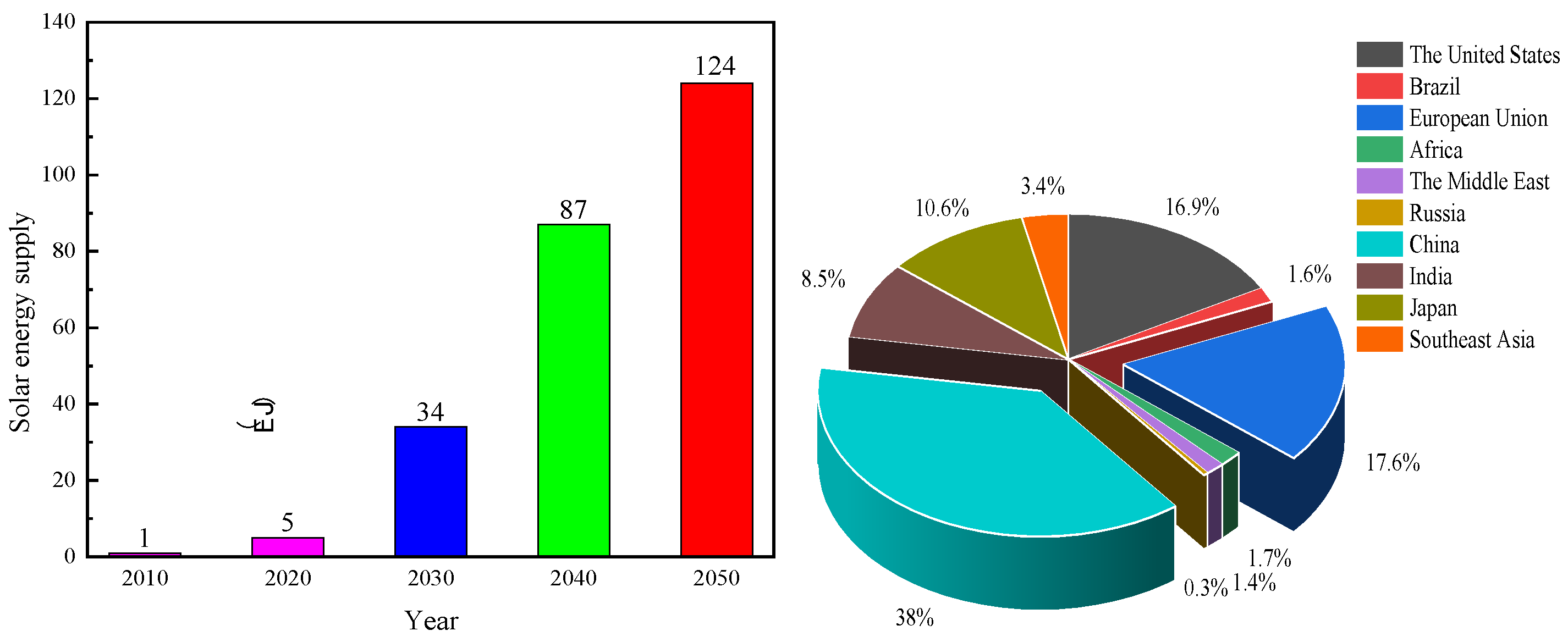
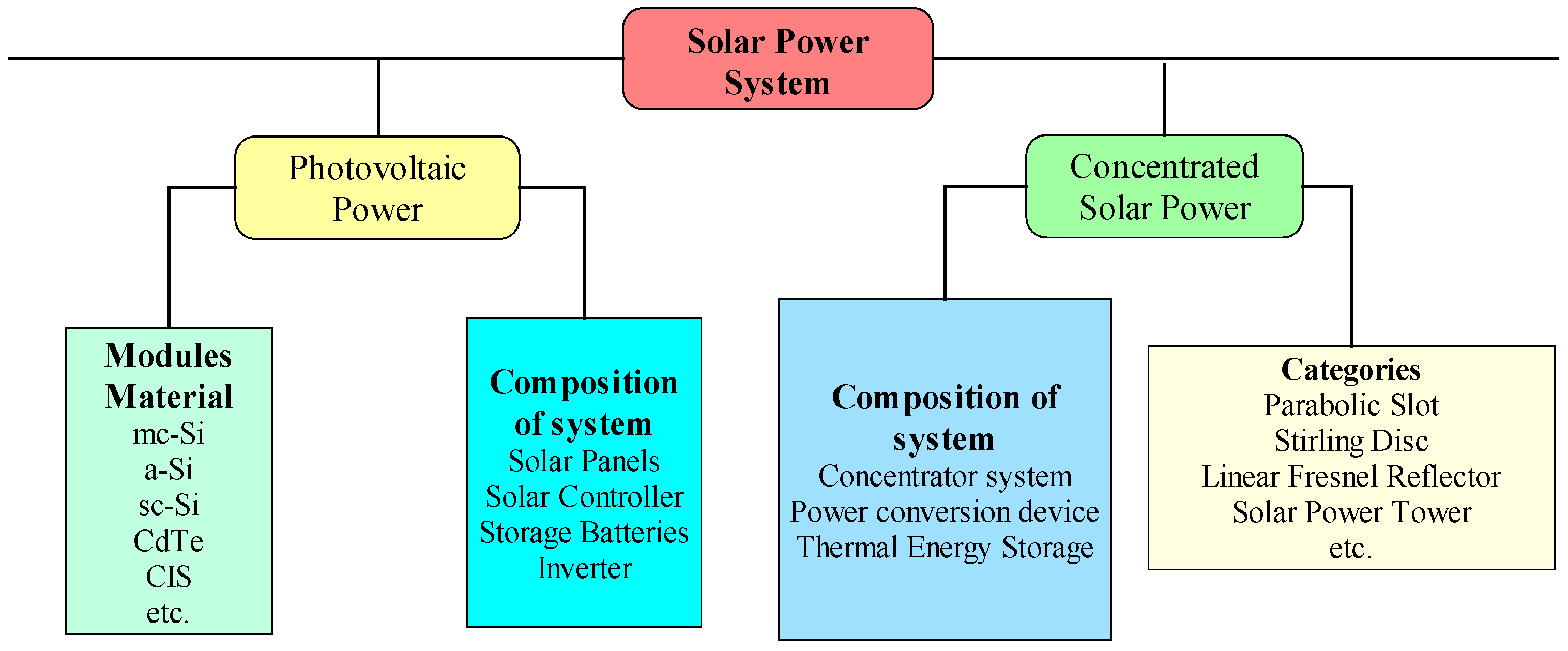
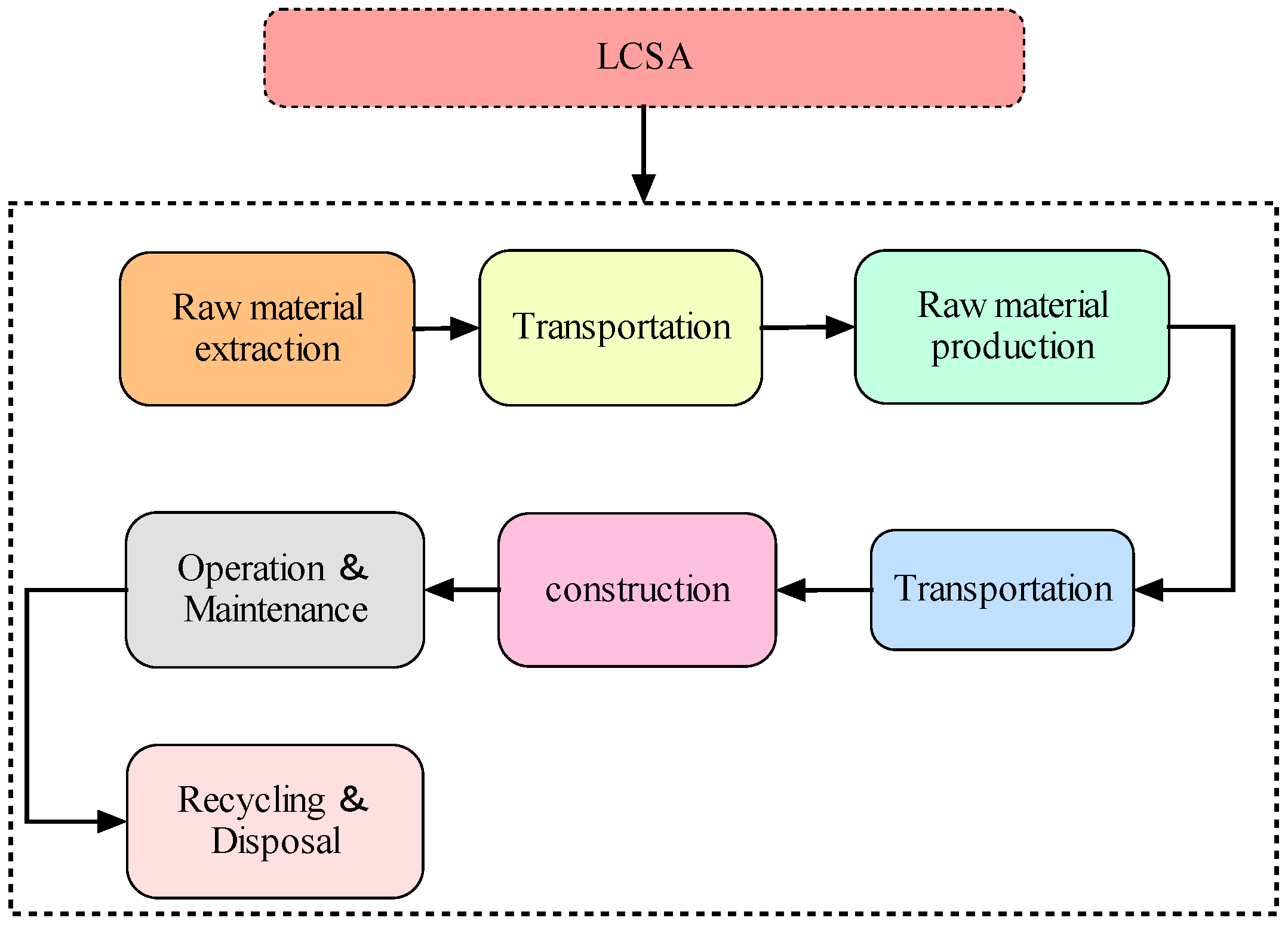
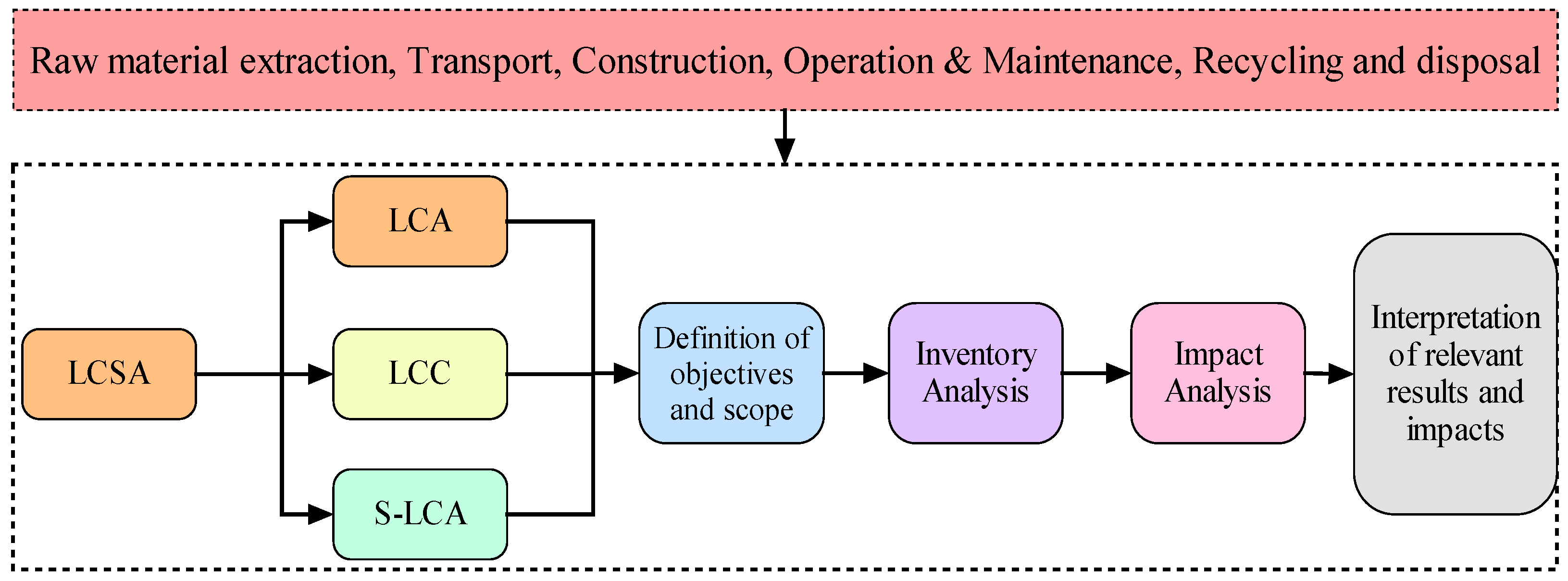
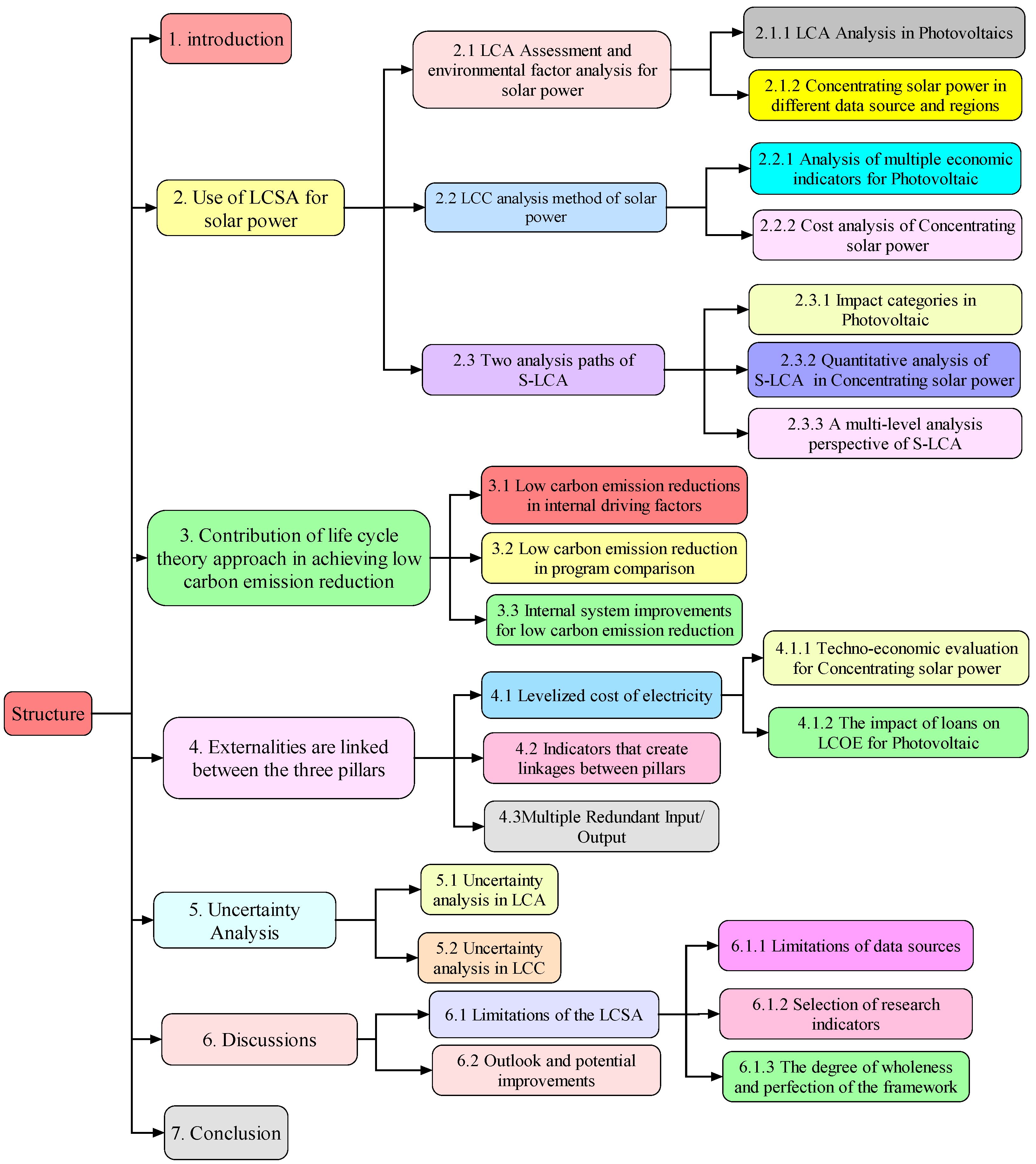
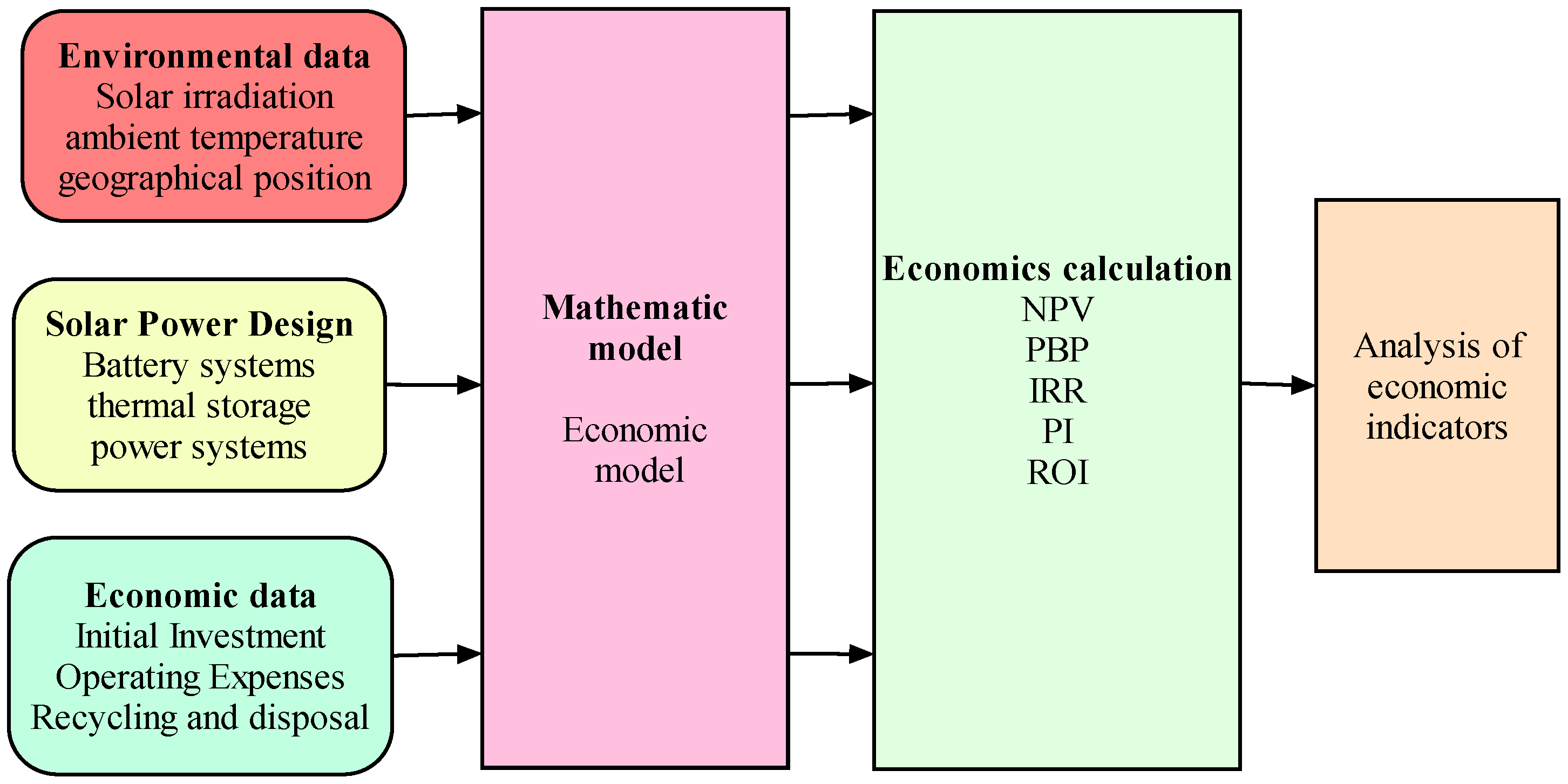


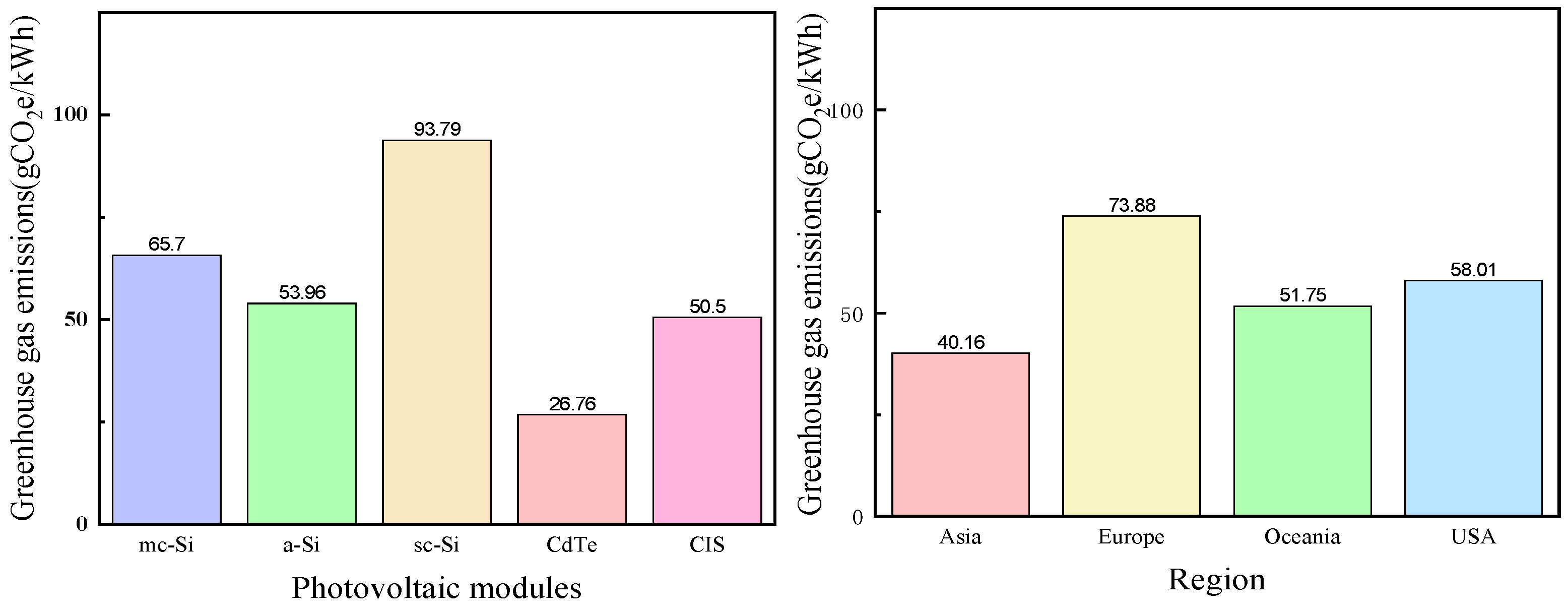
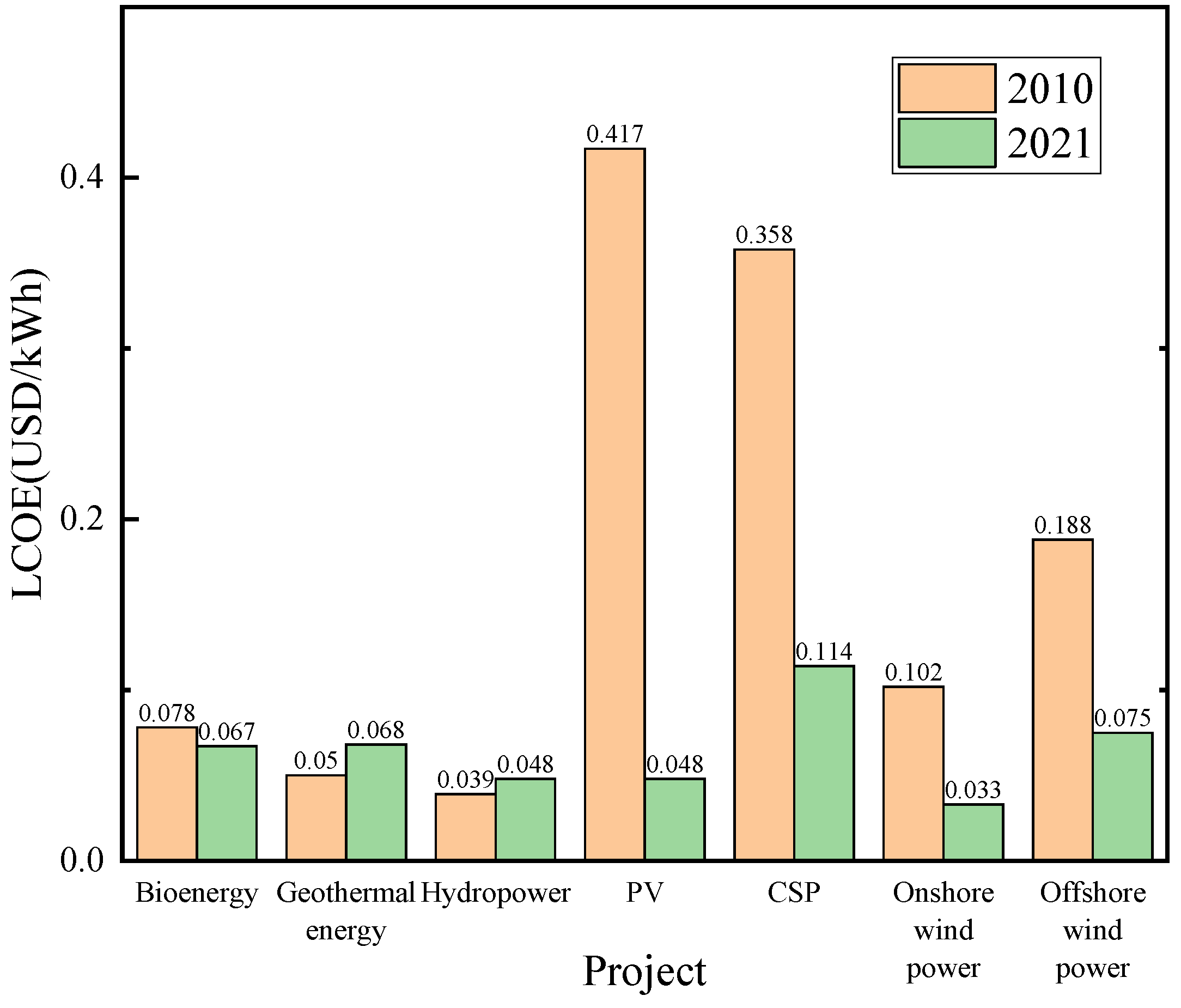
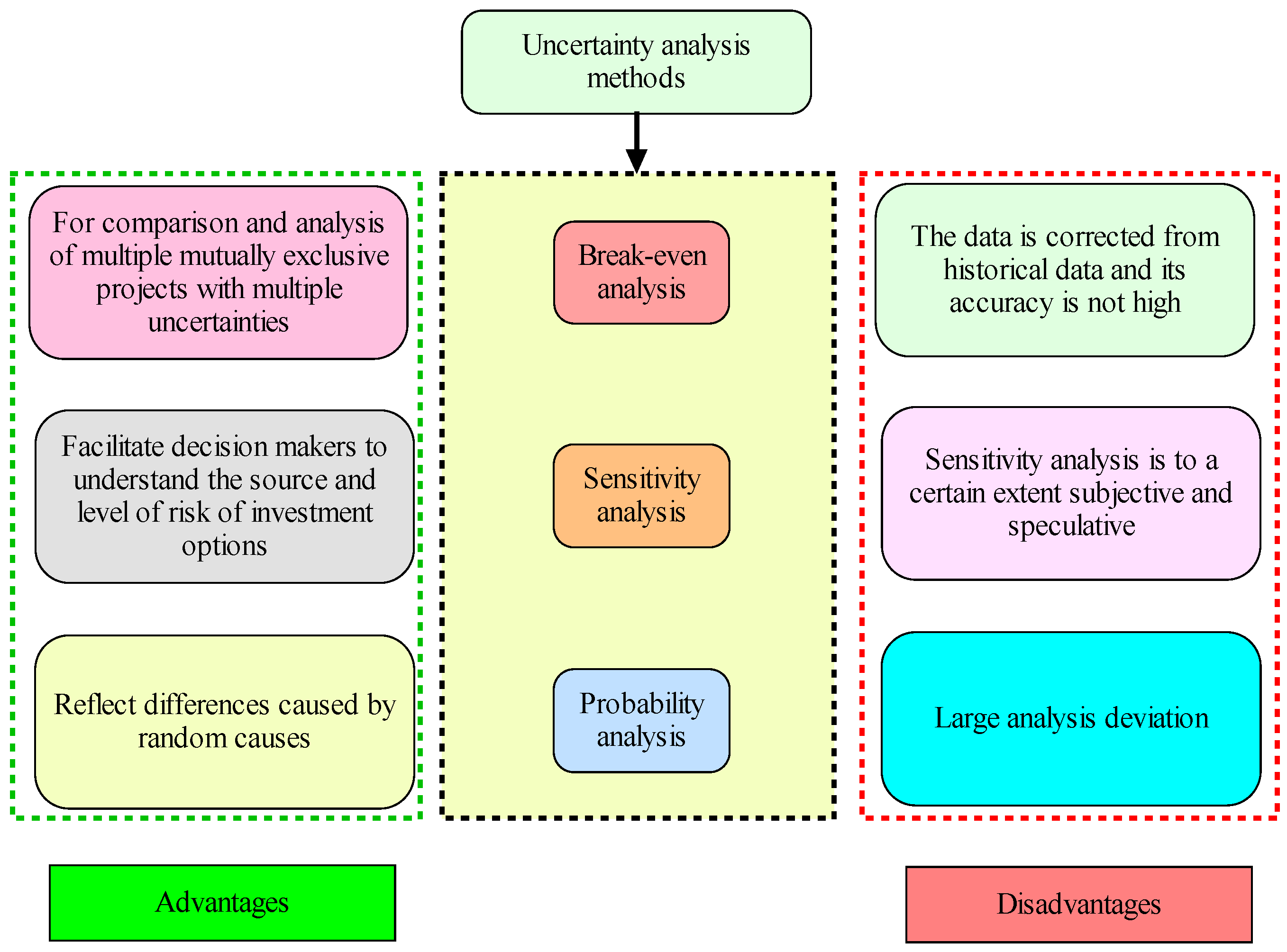
| Research Object | Location | Evaluation Indicators | Findings | Additional Discoveries/Comments |
|---|---|---|---|---|
| Solar heliostat; Telsnig et al. [42] | California | GWP (Global Warming Potential) | Conventional solar fields are the main contributors to GWP. | For power generation systems, compared to traditional heliostats, the impact of climate change is reduced by about 10%. The concept of a heliostat with independent renewable energy supply leads to a significant reduction in pollution emissions. |
| Single-crystalline Si solar cells; Mahmud et al. [43] | / | Multiple impact categories such as global warming potential, human toxicity, ozone depletion, GHG, etc. | Solar panels, batteries, and heat storage systems have a significant impact on the environment. | Solar photovoltaic frames have better environmental performance than solar thermal frames. |
| Monocrystalline and polycrystalline photovoltaic; Ali et al. [44] | New York State | GWP | Site location, capacity factor and system design (monocrystalline and polycrystalline panels, area power ratio) cause GWP differences. | Engaging in scrap management has a positive impact. |
| Photovoltaic power generation module; Miller et al. [45] | The United States, India, Australia, Europe, China, etc. | Carbon intensity (gCO2e/kWh) | The reversible temperature effect of the module increases the carbon intensity of silicon photovoltaic power generation installed in warm regions. | Mainstream forms of photovoltaic power generation have significantly lower lifetime greenhouse gas emissions than fossil fuels. |
| 2.7 kWp distributed solar photovoltaic system; Kannan et al. [46] | Singapore | EPBT, GHG | The greenhouse gas emissions generated by solar photovoltaic systems are lower than those of oil-fired steam turbine power plants and gas combined cycle power plants. | There is uncertainty in the environment of solar photovoltaic systems. |
| Molten salt concentrating solar power plants, oil power plants, and gas power plants; Piemonte et al. [47] | Italy | Multiple impact categories such as global warming potential, human toxicity, ozone depletion, etc. | CSP power plants are more desirable compared to traditional (oil and gas) power plants. | Further development is needed, mainly to improve the conversion efficiency from thermal energy to electrical energy. |
| Coupling System of Solar Photovoltaic and Wind Power Generation with Batteries; Ian Miller [48] | The United States, Egypt, Australia, Colombia, China, Germany, etc. | GHG | The carbon intensity of photovoltaic and wind power generation is still far lower than that of fossil power generation. | The approach to minimizing greenhouse gas emissions from coupled systems depends on the low-emission power generation given by the generator. |
| Molten Salt and Synthetic Oil in Trough-Focused Solar Energy; Batuecas et al. [49] | / | Multiple impact categories such as global warming potential, human toxicity, ozone depletion, etc. | Synthetic oil has a greater impact than molten salt. | Choosing a salt system is beneficial for environmental protection. |
| First- and second-generation photovoltaic cells (crystalline silicon/amorphous silicon); Soares et al. [50] | / | Emissions such as CO2 and nitrogen oxides | Compared to photovoltaic systems obtained from crystalline silicon, PV systems prepared from amorphous silicon exhibit a lower environmental impact and shorter energy recovery periods. | The development of third-generation photovoltaic cells with a high conversion efficiency and low environmental impact has received attention. |
| Distributed Concentrated Solar Combined Heat and Power (DCS-CHP) System; Norwood and Kammen [51] | America | GWP | Predicted global warming potential in Auckland City, California; any cogeneration system will reduce the demand for cooling while improving the overall solar efficiency of the system. | The prospect of distributed concentrated solar cogeneration coupled with seawater desalination is not optimistic. |
| Evaluation Indicators | Advantages | Disadvantages |
|---|---|---|
| NPV (Net Present Value) | Considering the time value of cash flow; reflecting the degree of investment risk. | NPV is sensitive to discount rates, and different discount rates may lead to different NPV values. |
| PBP (Payback Period) | Predicting short-term cash flows is relatively easy | Failure to consider the time value of funds and cash flows occurring after the payback period. |
| IRR (Internal Rate of Return) | Considers all cash flows of the project. | There is an issue with multiple IRRs within the project. |
| PI (Profitability Index) | Considering all cash flows, cash flows can be reinvested at the lowest rate of return. | Only indicates the relative profitability of the project. |
| ROI (Return on Investment) | Clearly reflects comprehensive profitability. | Lack of overall concept and consideration of the time value of funds. |
| Photovoltaic Modules | Greenhouse Gas Emissions (gCO2e/kWh) | Location | Scholars |
|---|---|---|---|
| mc-Si | 18 | Japan | Kabir et al. [114] |
| 189 | Switzerland | Dones and Frischknecht [115] | |
| 50 | Netherlands | Alsema [116] | |
| 12 | China | Ito et al. [117] | |
| 32 | Europe | Alsema et al. [118] | |
| 37 | Europe | Fthenakis and Alsema [119] | |
| 37 | Europe | Fthenakis and Kim [120] | |
| 72.4 | USA | Pacca et al. [121] | |
| 42 | China | Ito et al. [122] | |
| 180.3 | Italy | Bravi et al. [59] | |
| 30 | Europe and USA | Fthenakis and Kim [123] | |
| 88.74 | Italy | Desideri et al. [56] | |
| a-Si | 47 | Netherlands | Nieuwlaar et al. [124] |
| 15 | Japan | Kato et al. [114] | |
| 187.8 | USA | Lewis et al. [60] | |
| 50 | Netherlands | Alsema [116] | |
| 39 | USA | Meier [125] | |
| 34.3 | USA | Pacca et al. [121] | |
| 15.6 | China | Ito et al. [126] | |
| 43 | China | Ito et al. [122] | |
| sc-Si | 114 | Switzerland | Dones and Frischknecht [115] |
| 200 | Italy | Frankl et al. [127] | |
| 60 | Netherlands | Alsema [116] | |
| 35 | Europe | Alsema et al. [118] | |
| 165 | Singapore | Kannan et al. [46] | |
| 45 | Europe | Fthenakis and Kim [120] | |
| 131 | Spain | García-Valverde et al. [128] | |
| 51 | China | Ito et al. [122] | |
| 98.9 | Italy | Bravi et al. [59] | |
| 38 | Europe | Fthenakis and Kim [123] | |
| CdTe | 23.6 | USA | Fthenakis and Kim [129] |
| 25 | Europe | Alsema et al. [118] | |
| 16 | Europe | Fthenakis and Kim [120] | |
| 48 | Europe | Raugei et al. [130] | |
| 12.8 | China | Ito et al. [126] | |
| 51 | China | Ito et al. [122] | |
| 19 | Europe and USA | Fthenakis and Kim [123] | |
| 18.7 | Portugal | Held and Iig [131] | |
| CIS | 95 | Europe | Raugei et al. [130] |
| 10.5 | China | Ito et al. [126] | |
| 46 | China | Ito et al. [122] |
Disclaimer/Publisher’s Note: The statements, opinions and data contained in all publications are solely those of the individual author(s) and contributor(s) and not of MDPI and/or the editor(s). MDPI and/or the editor(s) disclaim responsibility for any injury to people or property resulting from any ideas, methods, instructions or products referred to in the content. |
© 2023 by the authors. Licensee MDPI, Basel, Switzerland. This article is an open access article distributed under the terms and conditions of the Creative Commons Attribution (CC BY) license (https://creativecommons.org/licenses/by/4.0/).
Share and Cite
Tan, D.; Wu, Y.; Zhang, Z.; Jiao, Y.; Zeng, L.; Meng, Y. Assessing the Life Cycle Sustainability of Solar Energy Production Systems: A Toolkit Review in the Context of Ensuring Environmental Performance Improvements. Sustainability 2023, 15, 11724. https://doi.org/10.3390/su151511724
Tan D, Wu Y, Zhang Z, Jiao Y, Zeng L, Meng Y. Assessing the Life Cycle Sustainability of Solar Energy Production Systems: A Toolkit Review in the Context of Ensuring Environmental Performance Improvements. Sustainability. 2023; 15(15):11724. https://doi.org/10.3390/su151511724
Chicago/Turabian StyleTan, Dongli, Yao Wu, Zhiqing Zhang, Yue Jiao, Lingchao Zeng, and Yujun Meng. 2023. "Assessing the Life Cycle Sustainability of Solar Energy Production Systems: A Toolkit Review in the Context of Ensuring Environmental Performance Improvements" Sustainability 15, no. 15: 11724. https://doi.org/10.3390/su151511724
APA StyleTan, D., Wu, Y., Zhang, Z., Jiao, Y., Zeng, L., & Meng, Y. (2023). Assessing the Life Cycle Sustainability of Solar Energy Production Systems: A Toolkit Review in the Context of Ensuring Environmental Performance Improvements. Sustainability, 15(15), 11724. https://doi.org/10.3390/su151511724






